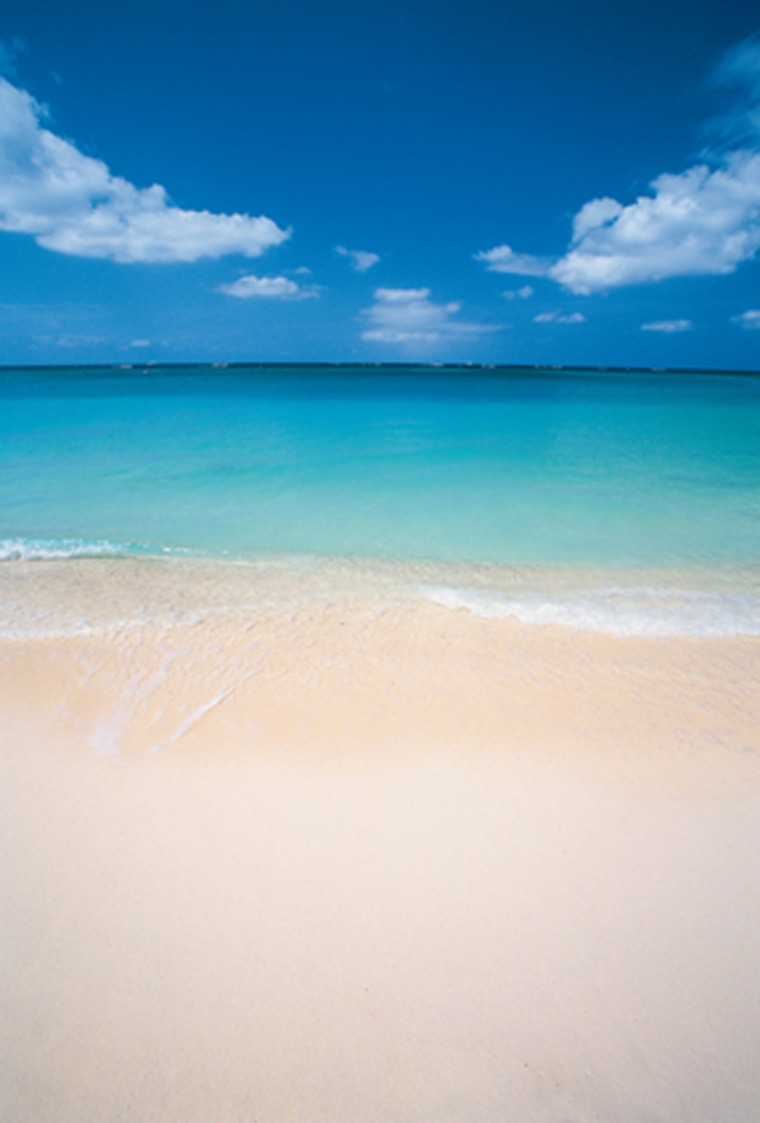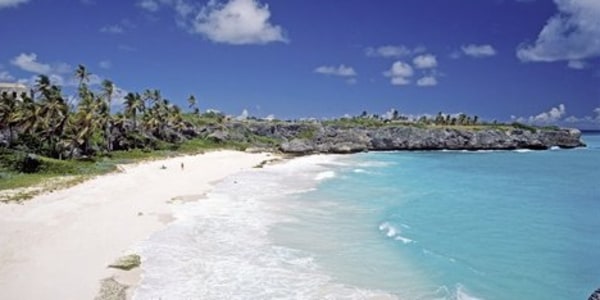Less than a year after getting walloped by Ivan De Terrible, the people of Grand Cayman have not only dug out and dusted off, but are looking forward to a future filled with calm seas and clear skies. And right now may be the best time in 20 years to visit.
At sunset, as I was on my way home from work, I pulled over at the public beach and watched as a solid line of dark clouds rose out of the ocean from the south. By the time I made it back to the northern end of West Bay, to the condo I shared with two other dive instructors, and walked out to the balcony, the center of the storm front had stretched up into a broad point like the head of a great black shark leaping from the sea to gobble the stars as soon as they appeared in the twilight. When lightning began to spray out of the shark’s nose, I filled a bucket with ice and grabbed a bottle of rum: This was cause for a celebration.
My roommates were already turning in for the night, so it was up to Mr. Appleton and me to form the welcoming party. I settled in at a gazebo on the edge of the ocean, poured a glass and watched as the storm slowly approached Grand Cayman. By 11 o’clock, it filled a third of the sky and had sucked away every whisper of wind and stilled the sea. At 1 a.m., the real lightshow began. Lightning arced from cloud to cloud to cloud, splitting and criss-crossing until it looked like the earth was covered in an electric spider web. At 3:30, the storm was nearly overhead, like a gigantic wave about to break. The roiling clouds flashed and pulsed but were strangely quiet save for a faint rumbling growl. I waited for the rippling peals of thunder. I waited for the wind.
I willed the storm to wash over the island. With the rash self-centeredness of youth, I saw it not as a threat, but as my salvation. High winds and heavy seas would mean that for the first time in more than two months I’d get a day off. After carrying countless tanks, teaching and entertaining an endless conveyor belt of guests, maintaining the rickety boat and leading as many as four dives a day without a break, no one felt he deserved the Caribbean version of a snow day more than I. A storm would mean I could stay in bed, as close to comatose as exhaustion and the rum could get me.
Slideshow 20 photos
Caribbean way of life
When the glow from my dive watch said 4 a.m., I looked straight up to where the dusky edge of the clouds met the clear-black, star-filled sky. It took me a moment to notice something odd. Just a few minutes before, I could only see Orion’s belt; now I could see up the great hunter’s dress. Suddenly it sank in: The storm was retreating, and with it my chances for a day off. I had to be at work in three hours.
The old divemasters’ trick of surreptitiously sucking the pure oxygen out of the first-aid kit got me through the next day, but I never forgave that storm. I left Grand Cayman after a year and never went back — too many other islands to see and other dives to do — until now.
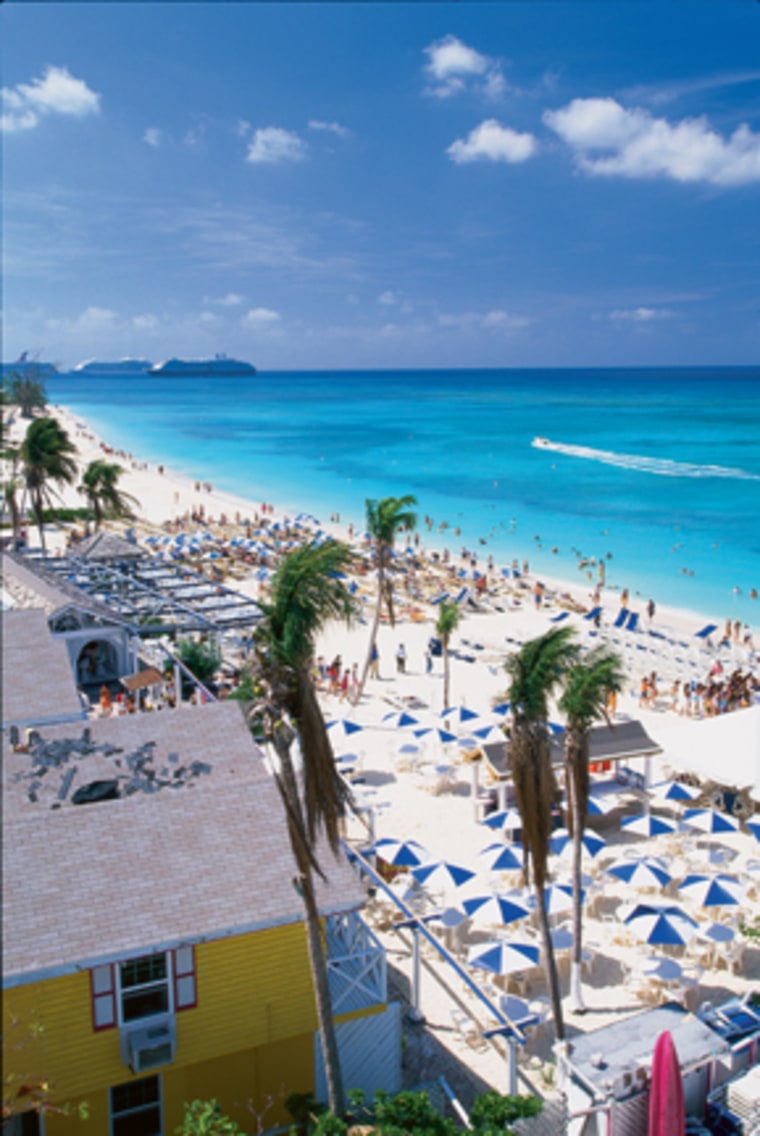
Standing today at the exact same spot where, 20 years ago, I waited for wind to blow and waves to grow angry, I realize how foolish I was. Last year, another monster rose from the south and threatened the island. But this one didn’t back down. If someone was sitting at the Dolphin Point gazebo to welcome Ivan, his body is probably still in a tree — on Cuba. The gazebo itself is gone; only bits of foundation remain on the ironshore. A guy who rode out the storm in a condo next to the one I lived in said that when the storm surge reached its high-water mark the sea was just inches below the second-floor balconies. All the lower units were totaled. The ocean crashed in through the front doors and windows and carried away every possession when it blew out the back. Because the insurance claims here have yet to be settled, the grounds are a still bomb site, with purses, shoes, toys, roofs, hot-water heaters and green pieces of tennis court scattered all over. It’s a disheartening first stop on my homecoming tour, but as I drive away, I can hear the buzz of power tools all around the neighborhood.
I’m not sure what to expect when I check in at a small divers’ retreat, Cobalt Coast, built at the edge of the famed North Wall, a precipitous bulwark of ancient coral feathered with fresh growth and patrolled by flights of eagle rays. But as I step through the breezeway and into the pergola-covered dining area, everything looks to be in perfect shape. I grab a cold drink at the bar and walk around the oceanfront pool to watch a team of divers gear up and climb down into the water at the end of a long pier that points directly at the north wall.
Talking to Arie Barendrecht, Cobalt Coast’s owner, and Nancy Easterbrook of Divetech, which has bases here and at Turtle Reef, I hear the good news: This side of the island was protected from the worst of the storm — the resort was barely ruffled, and the spectacular deep reef was untouched. I sign up to do a dive the next morning and drop my gear in a locker. The shop is about 10 steps from my suite, which has a view of the ocean. For a diver, it couldn’t be more convenient or inspiring.
Though most of the people I knew 20 years ago on Cayman also moved away, those who stayed have fashioned successful careers. For a homecoming dinner, I hook up with Collin Pearson, a former scuba instructor who married a Cayman citizen and now owns a marine services company. He and his wife, Olive, meet me at Champion House II, a locals’ favorite just outside George Town. After two decades, I’m happy to see that Collin has retained the shock of red hair, glasses and permanently astonished look that led the dive crowd to nickname him Beaker, after the Muppets character.
We order a down-home Cayman feast that fills the table with conch, lobster, turtle and snapper. The conversation naturally turns to their hurricane story. They’d moved into their new house about a mile from the water just a week before the storm hit, thrilled with the extra space and features like a spiral staircase, tile floors and sunken living room. On September 11, when the change in Ivan’s course that everyone had been praying for didn’t happen, Collin and Olive invited all their friends and acquaintances who lived in more exposed areas to come hunker down at the house. As the weather reports grew gloomier, showing the Category 5 storm — the strongest hurricane to hit the Caribbean in 10 years and the sixth-strongest ever, one that had already delivered a deadly pummeling to Grenada and Jamaica — headed right for them, they boarded up as best they could. “Then I went to sleep,” says Collin.
“How could you possibly sleep?” I ask.
“I had a feeling I was going to need it,” he says.
At 10 p.m., when the eye of the storm was still 113 miles southeast of Grand Cayman, the winds screaming across the island had already reached 100 mph. “That’s when the water really started pouring in under the front door,” says Olive. The water ran across the floor and into the sunken living room.
“By this time,” notes Collin, “I was wide awake.
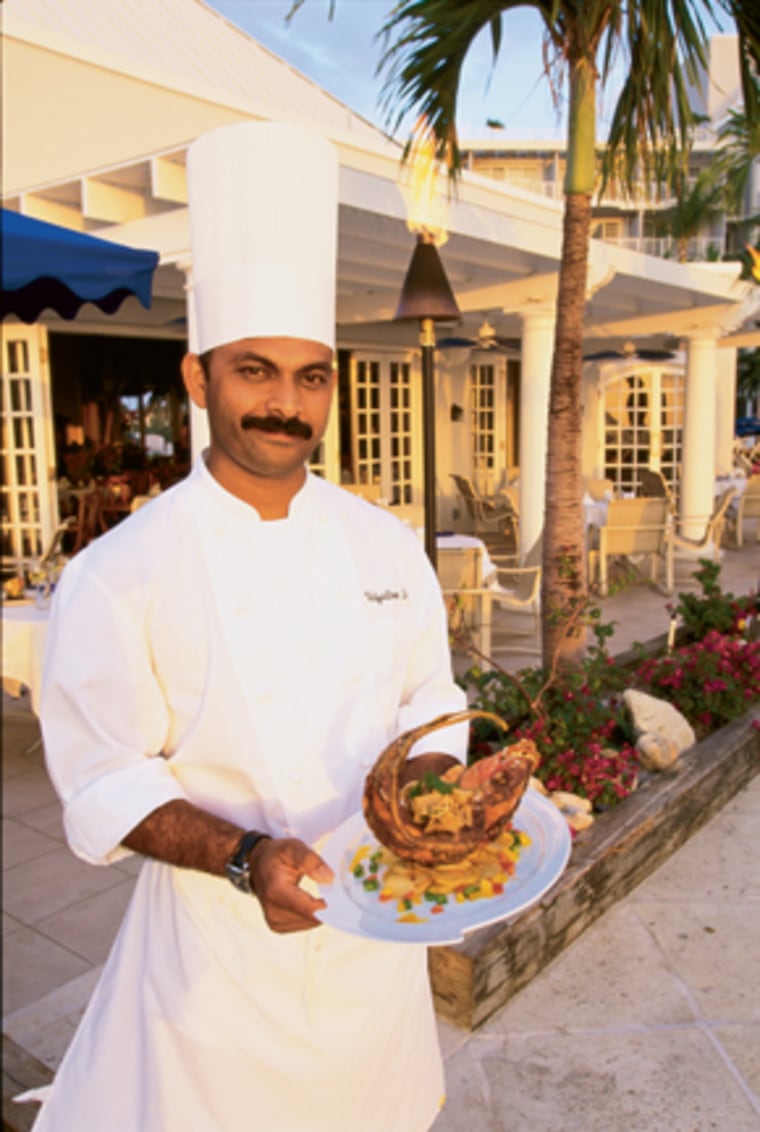
The water level rose quickly, and they formed a bucket brigade to bail out the living room. As fast as they could, they dumped the water down the sink. But it kept rising. Then the lights went out. Flashlights reflecting off what was now an indoor pool created eerie ripples of light on the walls, matching the mood produced by the screeching winds and creaking house. “Around midnight, I shined my light down into the sunken bloody living room,” says Collin, “and there was a school of minnows swimming around!”
They couldn’t see what was going on outside, but knew that having live saltwater fish inside their house was not a good sign. By one in the morning, the water overflowed the four-foot-deep living room and started filling up the first floor. “We picked up all the furniture and carried it as far up the winding staircase as it would go,” says Olive. “Of course, the big things got wedged halfway up and we had to climb over them going up and down.”
At 2 a.m., with water coming in under all four of the house’s doors, they gave up bailing. A wrenching sound at the front was part of the roof ripping off. “And that’s when the back door blew open,” says Collin.
By 10 a.m. the eye was 21 miles southwest of Grand Cayman, as close as it would get. Unfortunately, that put the island in the worst quadrant of the storm, which lashed out with winds of 150 mph and gusts up to 220. At the Pearsons’, the ceilings in three rooms caved in, the drywall soaked with water that had rained in through rifts in the roof. By the time the wind finally dropped, Ivan had pounded the island for 16 hours.
Today, six months after the storm, there are great swaths of ceiling yet to be repaired, and there’s tarpaper on the roof waiting to be covered. But it’s still a home. Actually, a group home: $1.4 billion out of Grand Cayman’s $3.4 billion in total damages was to residences, and the Pearsons opened their house to displaced friends and friends of friends. Eight people are still living under one patched roof.
On the Divetech boat the next morning, I’m nervous. There’s a bit of a breeze out of the north, so the captain says we’re going to dive a West Bay wall, where the water is almost always calm. When I worked here, the boat I ran was a small flat-bottom trimaran more suitable for taking a family of four on a lake picnic than for what I actually did with it: take a dozen divers out to a 2,000-foot drop-off in the open ocean. So I didn’t dare leave the protected waters of West Bay unless it was mirror-calm. Consequently, I dove all the famous spots — Orange Canyon, Trinity Caves, the wreck of the Oro Verde and my favorite, Big Tunnels — over 100 times each. It’s not a complaint: These are some of the best dives in the world. Or they were.
As we motor out toward the wall, Dolphin Point comes into view. The towering waves that devastated the condo had raced up West Bay, right overtop the wall, and slammed into the coast where it elbows out. As I ready my gear, I wonder how rough it got underwater.
When I feel the boat slow, I look back along the coast to figure out which site we’re at. Back in 1985, mooring balls were just beginning to be planted along the reef, so at most spots I still had to drop an anchor in the sandy areas behind the coral. To find particular sections of the wall, I memorized line-ups such as steering west until the second telephone pole lined up with the seventh palm tree and then north or south until the third street light lined up with the northwest corner of the brown condo. But when I look along the shoreline now, I’m totally lost. Not only are most of the trees and poles gone due to Ivan, but it’s obvious that another kind of storm has swept over the island during the last 20 years. Where there had been a few condos and a couple of hotels on Seven Mile Beach, now there is a nearly solid line of buildings, including the new Four Seasons — still under construction but already showing off its tradition-breaking variance that allows it to rise above the palm trees.
As the mate ties us off to the mooring buoy, the divemaster starts his briefing by drawing a picture of the site. It’s Big Tunnels. I strap on my tank and anxiously wait for the word to head down.
On the bottom, there’s a plaque asking divers to protect and respect the fragile reef. As I swim past, heading for the first tunnel, I’m hoping Ivan could read. I stay right on the fins of the divemaster. Big Tunnels was my favorite not only because it was a wondrous, intricately sculpted reef, but because it was the most fun to guide. And the Divetech guy starts it right, with a plunge into the mouth of the first large cavern. I do it old-school, taking a sharp angle straight down into the dim opening, then barrel roll and swim upside down following the contour of the cave as it forms a J, examining the solitary corals clinging to the ceiling until I sense that I’m near the end. I roll back over and look down to find myself at 130 feet staring into the abyss — the tunnel ends at the very edge of the wall. I bubble out a laugh, remembering how many guests I had to go chasing after at this very spot when the magnetic, bottomless blue pulled them deeper and deeper.
I’m euphoric, and it’s only partially due to the nitrogen narcosis. The dive is the same wonderful game of zero-gravity follow-the-leader in and out, up and down the tunnels that ant-farm through the massive pinnacles. More importantly, though, the corals, which on the most pristine of reefs form just a thin patina of vibrant life atop the remains of their ancestors, look healthy and undamaged.
On the ride back to the dock, the captain tells me how for six weekends in a row after the storm, every available dive boat set out loaded with volunteers who scoured the reefs, picking up every fence post, roof shingle and satellite dish they found before it could grind against the coral.
The same kind of effort was made on an even larger scale along Seven Mile Beach, the island’s shining jewel when it comes to topside attractions. I move down to the Hyatt, and over dinner at its top-rated Hemingways restaurant, Mark Bastis, general manager of the resort as well as president of the hotel association, tells me how, within days of the storm, the government put out the call to raise an army. Anyone who wasn’t already at work rebuilding their homes or businesses was marshaled at one end of West Bay. The force, made up mainly of Jamaican women, marched up the road, gathering tons of siding, shingles, branches, car parts, boat parts — everything that Ivan tore up and tossed around. They did a remarkable job, and the island’s main artery and its world-famous beach were cleaned up in short order.
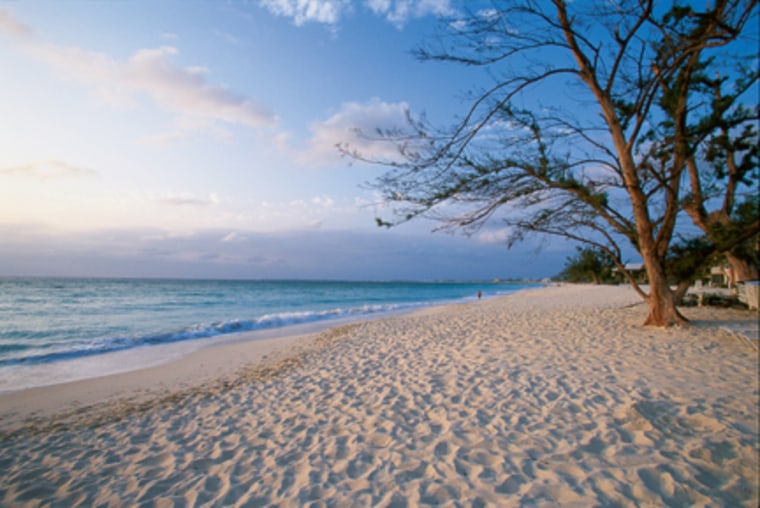
I ask Bastis about the hotels. He says that though nearly every hotel was damaged, he expects that 75 percent of the room stock will be back online by the end of this year and 100 percent by early 2006. His own resort has only partially recovered. I’m staying in a plush beach suite, one of 53 units reopened directly on Seven Mile Beach. Bastis says that they expected this complex facing the water to bear the brunt of the damage, but since the winds ran parallel to the beach, no big waves hit the main stretch. They didn’t expect a sneak attack from the rear, though. Just when many along West Bay thought the worst of the hurricane was over, the storm surge raised the level of North Sound some nine feet. The water overflowed the canals, lifting boats out of the marina and piling them in backyards. Seawater flooded everything east of the beach, including the entire first level of the Hyatt’s 236-unit building that stands more than 100 yards from the ocean.
As I tour the rest of the island, there are amazing stories at every stop. During a dinner of crab cakes with chardonnay lobster sauce at the Cracked Conch, the waiter tells me how waves snapped off their dock’s concrete pilings like breadsticks. Alan Rosenblum, another diver from way back who was smart enough to go into the real estate business, describes the week after the storm as “Mad Max time,” when gasoline was in such short supply that people resorted to siphoning it out of cars that had been thrown up into trees. A policewoman told me how in Bodden Town, on the south side of the island — which bore the brunt of Ivan — a squad of cops was holed up in their station house at the very height of the storm, wondering if it was the end of the world, when they heard an insistent banging at the door. Thinking no living person could be out in such horrific winds, they at first ignored it. But when it didn’t stop, they pried open the door. They’d been right: It was no living person. When the ocean rose up over the beach, it flooded a sea-view cemetery, exhuming a recently buried casket and carrying it over the dune, across the street and down to the police station where it ended its final voyage on their doorstep.
Mansions at Old Prospect Point still look like cannons were rolled up to their doors and fired; all that’s left of some small hotels and bars I knew are a few twisted lengths of rebar. Whole forests of casuarinas lay flattened. But everywhere I go I also see rebirth, and everyone who tells me a story of watching their roof blow away follows it with their plans for the future, of new tourism businesses, of the chance this has given them to redesign and remodel, and how the storm brought an island populated by a mishmash of expats, permit workers and locals together as a community.
The beach is still as stunning as ever, maybe even more so — or maybe I finally had the luxury of walking its golden sands without carrying scuba tanks. Resorts like the Westin have been almost fully booked since they reopened, and many of the guests are repeaters who have been coming for years and are thrilled to visit now when there’s only a fraction of the usual number of people on the island. The miles of beach not on the cruise-shippers’ hit lists are empty, and boats have their pick of the best dive sites. The Stingrays are still in the City, the farm is still full of turtles, Hell is still welcoming all comers, and there are more restaurants and bars open than anyone could sample in a two-month stay.
I find the perfect example of the Caymanians’ positive attitude when I stop at Reef Resort, an east-end operation painted the color of the sunrise that rises over the fringing reef just off its sandy beach. The property sustained $7 million in damage, but the local owners didn’t even wait for the insurance adjuster. They rebuilt and repaired and are going full-steam ahead with new condos, which they expect to sell out during preconstruction.
The Barefoot Man — who was the island’s favorite entertainer long before I got here — now plays exclusively at the Reef Resort’s Castro’s Hideaway, and as the resort’s general manager, Tom McCallum, and I listen to Barefoot’s latest hit, “Ivan,” I say that as far as I can see, the only concession they’ve made to the storm is the new bar we’re drinking at. It’s made of poured concrete — what looks like several tons of it. If ever another storm approaches Grand Cayman and I happen to be on the island, I just may strap myself and my bottle of rum to this bar and watch it hit.
But as far as everyone on Grand Cayman is concerned, there’s little chance of that happening. The storm of the century has come and gone. And it’s only 2005: They have a calm, clear 95 years to look forward to before they’ll have to worry about what’s lurking in the southern skies.

Comfort Suites & Resort Grand Cayman
Style: Family-friendly with spacious suites
Location: West Bay Road, Grand Cayman
Rooms: 108
Amenities: Pool and hot tub; water sports
Dining: Stingers poolside bar & restaurant
Contact: 800-517-4000
Hurricane Update: Three out of five floors have been restored and given a tropical makeover.
Courtyard by Marriott Grand Cayman
Style: Stylish comfort
Location: West Bay Road, Grand Cayman
Rooms: 231
Amenities: Pool; water sports; fitness trail
Dining: Mangrove Grill; Sea Grape Café
Contact: 345-946-4433
Hurricane Update: Back in business since November 20, it’s running at full capacity.
Divi Tiara Beach Resort
Style: Dive, Dive, Dive!
Location: Cayman Brac
Rooms: 71 Guestrooms and suites
Amenities: PADI Five Star dive operation; fully equipped dive shop; freshwater pool
Dining: Poseidon Restaurant; Turtles Bar
Contact: 800-367-3484
Hurricane Update: The resort received minimal damage and is fully operational
Grand Cayman Marriott Beach Resort
Style: Beachfront tranquility
Location: Seven Mile Beach, Grand Cayman
Rooms: 307 rooms and suites
Amenities: Spa; fitness room; beachfront pool; whirlpool; water sports
Dining: The Grille and The Peninsula
Contact: 345-949-0088
Hurricane Update: A $15 million remodeling project is under way. The pool, beach, oceanfront restaurants, bars and 75 percent of the rooms opened June 1. All renovations will be done by August 1.
Hyatt Regency Grand Cayman
Style: Carefree luxury
Location: Seven Mile Beach, Grand Cayman
Rooms: 53 suites
Amenities: Two pools and a whirlpool; water sports; spa; health club; children’s program
Dining: Bamboo; Hemingways; Rum Point’s Wreck Bar
Contact: 800-55-HYATT
Hurricane Update: The resort re-opened 53 beach suites on December 15. Renovations for the main resort will be completed by February 1, 2006.
The Reef Resort
Style: Beach club with diving
Location: East End, Grand Cayman
Rooms: 74
Amenities: Wireless Internet; concierge service; PADI 5-star dive center; tennis court; volleyball; three pools
Dining: Castro’s Hideaway Beach Bar and Grill; Thirsty Surfer
Contact: 888-232-0541
Hurricane Update: High-speed wireless Internet across the entire grounds and a new beach bar are some of the post-Ivan upgrades.
Southern Cross Club
Style: Diver’s paradise
Location: Little Cayman
Rooms: 7
Amenities: Scuba diving; guided fish trips
Dining: Lucky Drum
Contact: 800-899-2582
Hurricane Update: Up and running since October, it’s still undergoing renovations and additions. The Lucky Drum restaurant boasts a new screened dining pavilion. Five beach bungalow additions are currently under construction and will be available this summer.
Sunset House
Style: Diver-friendly resort
Location: George Town, Grand Cayman
Rooms: 57
Amenities: Full-service dive shop; pool and hot tub; sea pool; photography lessons
Dining: SeaHarvest Restaurant; My Bar
Contact: 888-854-4767
Hurricane Update: It’s re-opened with accommodations redecorated and pool retiled. A new dive shop is still under construction.
The Westin Casuarina Resort & Spa
Style: Relaxed tropical escape
Location: Seven Mile Beach, Grand Cayman
Rooms: 343
Amenities: Water sports; fitness and spa facilities; swim-up pool bar
Dining: Casa Havana; Ferdinand’s; Courtyard Café
Contact: 345-945-3800
Hurricane Update: It reopened in November.
is the magazine for anyone in search of the perfect tropical getaway. Each issue presents expert insider’s advice on where to find the Caribbean’s best beaches and attractions, its finest resorts and spas, liveliest beach bars and activities, and its friendliest people.
